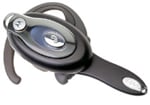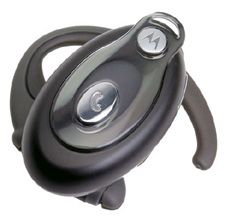Review: Motorola HS-850

James Hromadka of TreoCentral reviews the Motorols HS850 bluetooth headset. Read on for the full review.
Bluetooth headsets for me have always been a mixed bag. Sound quality, usability, price—pick two, as you never seem to get all three in a headset. The Motorola HS850 is an improved version of the HS810 [read review], so I had high hopes that Motorola would have fixed some of the issues the review raised, and that the HS850 would fill the bill and have all three characteristics of a good headset.
Setup
The HS850 offers up to 8 hours of talk time or 200 hours of standby time. Charging the device completely takes about two hours. Its earpiece can be worn on either ear, and the device has a boom mic that folds away when not in use. Pairing the HS850 is simple enough. Hold the multifunction button down for three seconds, then open the boom mic when the blue LED is lit. Go through the Treo's Hands-free Setup, and you're done.
Usability

I found that the boom is incredibly convenient. Open it to turn the headset on; close the boom to turn the headset off. Other headsets usually require holding a button for a few seconds, and I always forgot to do that, so the battery would run out sooner. Because of the boom, there is no worrying about leaving the headset on. That 200 hours of standby time turns into weeks of time between charges if you only use the headset in the car as I do. The headset is also very tiny when closed, so you can keep it in your pocket or hang it around your neck with the included lanyard.
The multifunction (MF) button is used just like any other headset, such as answering or hanging up a call. There are volume buttons on the top and bottom of the headset. The manual has instructions on how to configure which button is “volume up.” Speaking of the manual, it has instructions in over fifteen languages, yet is concise (English version is 9 pages) and clear. The illustrations on changing the earpiece between right and left ears are useful, and there are tables that outline the MF button’s uses, warning tone & LED meanings.

If a call comes in and the boom is open, just press the multifunction button to answer the call. If the boom is closed, opening the boom does not answer the call. You can either wait for the Treo to connect to the HS850 or press the MF button twice—once to connect, once to answer. Interestingly enough, the HS850 manual says you only have to open the boom to answer a call. This quick-answer feature works when I use the HS850 with another phone (Sony Ericsson K700) but not with the Treo. About the only thing I found annoying with the HS850 is that after completing a call, the Treo would go out of headset mode. I would then have to press the MF button to enter headset mode (the Bluetooth icon turns into a headset) again. I blame the Treo 650 for this quirkiness, and it does not detract much from the HS850's otherwise perfect usability.
Audio quality is excellent on the HS850. The speaker output is better than the one on the Treo 650. In normal situations, I have to max the Treo’s handset volume, while the HS850 I can keep turned down a bit. The microphone on the HS850 is also very good. People did not even know I was using a headset when talking to them, and I believe that is the best test of a Bluetooth headset.
Get the Windows Central Newsletter
All the latest news, reviews, and guides for Windows and Xbox diehards.
Conclusion
So does the Motorola HS850 meet the three-tier test for headsets? Absolutely. With excellent audio quality, a folding boom mic that keeps you from leaving the device on, and battery life that makes the additional price worthwhile, the HS850 should be on the shortlist of anyone looking for a Bluetooth headset.
| Ratings (out of 5)design: 5comfort: 4sound quality: 4cost/benefit: 4Overall: 4 | ProsGreat battery lifeDiminutive sizeExcellent audio qualityConsjust a little some quirkiness in hands-free mode |
(Originally published at TreoCentral on Mar 22, 2005)
Home to the most invested and passionate Microsoft fans, Windows Central is the next generation destination for news, reviews, advice and buying recommendations on the Windows, PC and Xbox ecosystems, following all products, apps, software, AI advancements, and accessories. We've been around for more than decade, and we take our jobs seriously. Windows Central writers and editors value accuracy and editorial independence in everything we do, never receiving compensation for coverage and never pulling punches.
